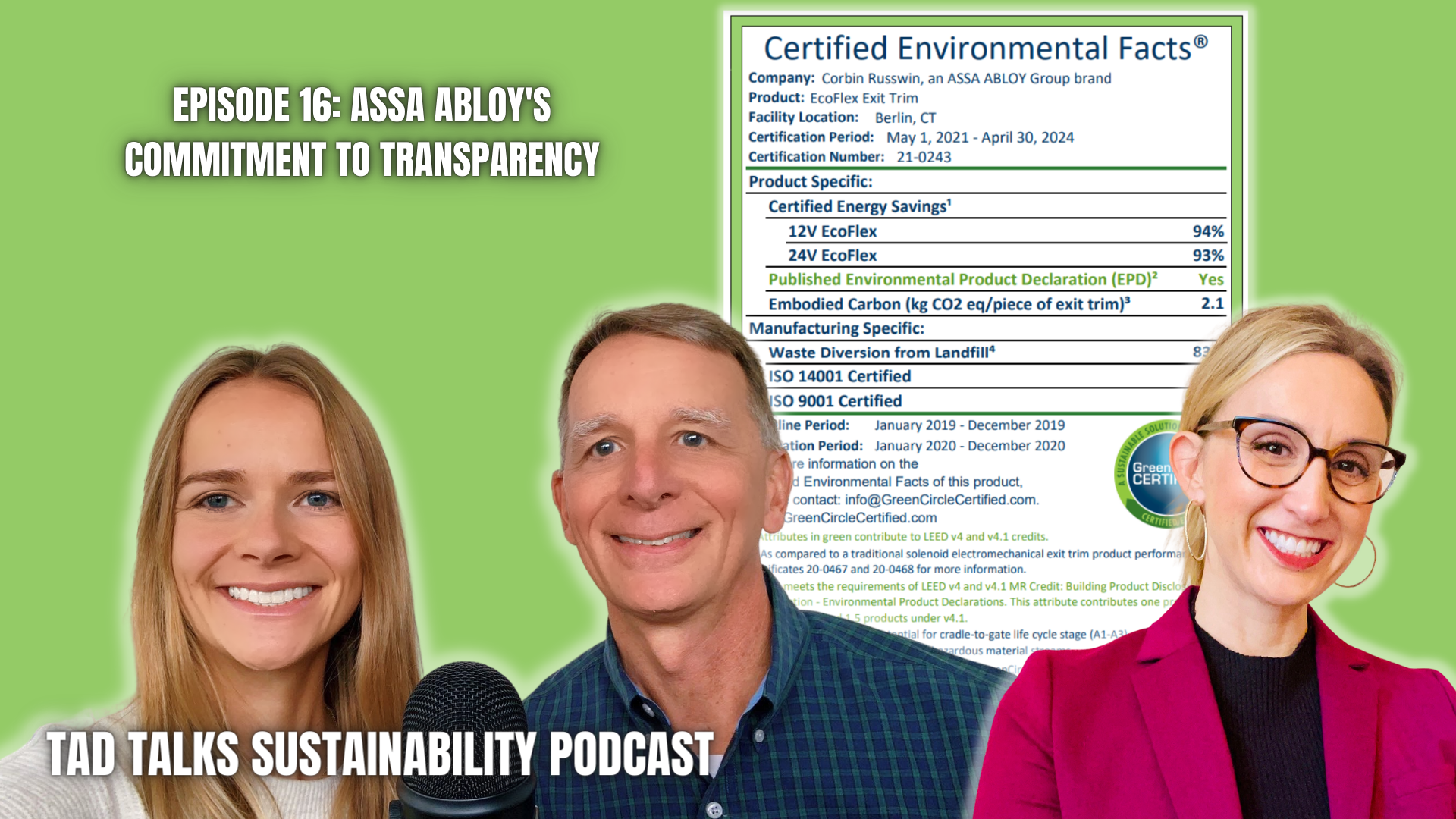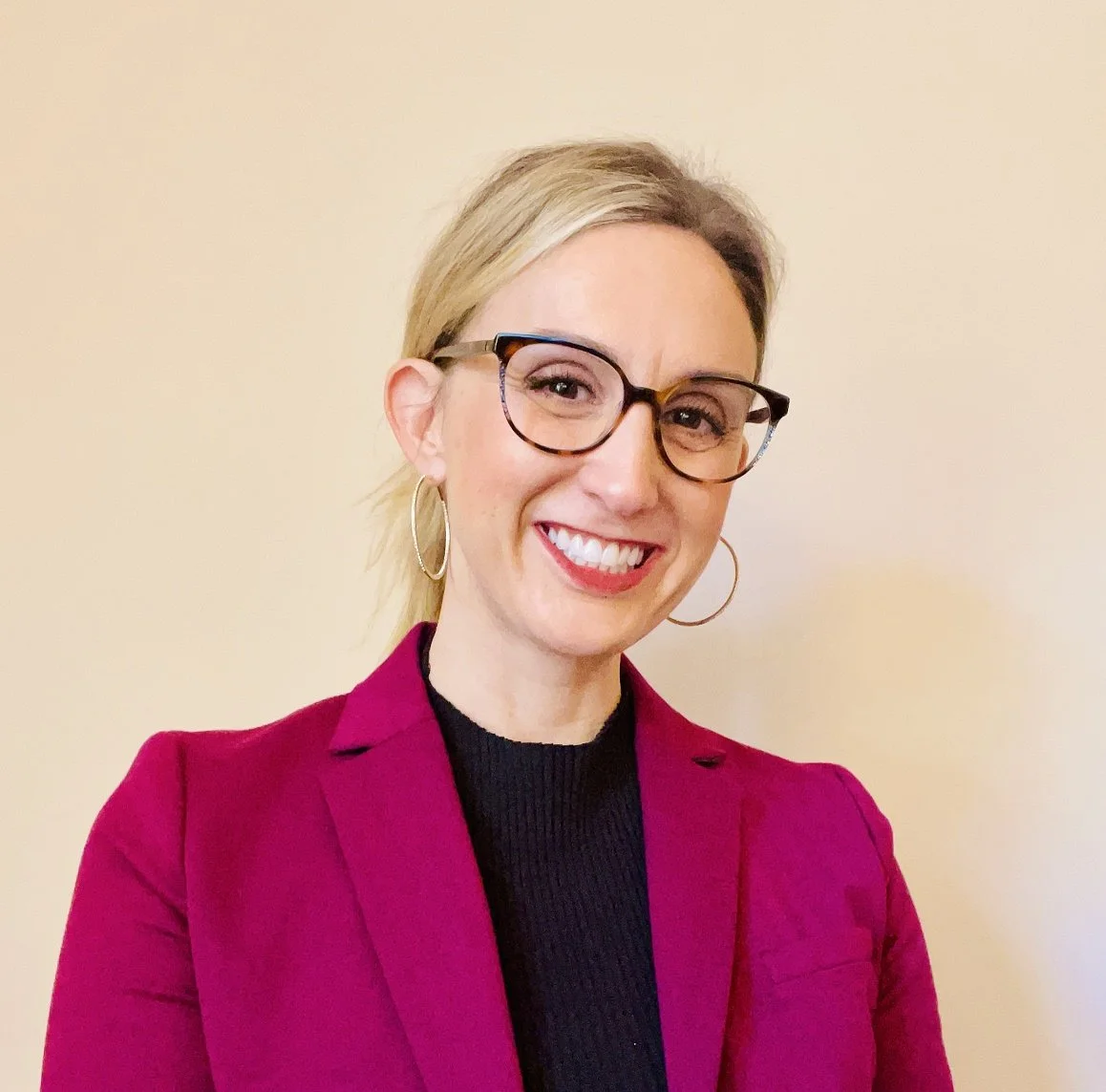Episode 16: Improving Building Efficiency with Sustainable Doors and Hardware with Amy Musanti from ASSA ABLOY
Click the links below to listen to the full episode
According to the World Green Building Council’s Global Status Report 2017, the building industry accounts for 39% of the world’s carbon emissions. One way to reduce these emissions is to install sustainable doors and hardware. In this episode, Tad and Julianna sit down with Amy Musanti Director of Sustainability for ASSA ABLOY, to discuss ASSA ABLOY’s sustainability journey, how ASSA ABLOY is optimizing their products to be more sustainable, the sustainability compass they use in their new product development process, their 150+ GreenCircle certifications, and what’s next for the building industry.
how you are making your products more sustainable?
“On the energy efficiency side, we're not the obvious product when we think about contributors to a better building envelope or a better building operational footprint overall, right? So we bring products to market and then have to think really creatively about how we're teaching our customers to integrate these products into their building. So there are two buckets when it comes to energy efficiency. One is taking a look at the exterior envelope, and then the other is taking a look at products that are electrified. So with the exterior envelope we have spent a lot of time and resources, developing products that contribute to a much more sealed up exterior envelope.
When you're in a building you look around the opening and if you can see gaps around that opening and you can see the outside from the inside, that means that there's some energy loss going on there. You’re also losing some money as well. So we take a look at designing and testing exterior envelope products that work together as a system. So it's not just one piece of the puzzle or another. It's the door, the frame, the gasketing, the thermally broken threshold, and the door operator that helps to ensure that the product or that the opening stays open just as long as it needs to, and then closes again so that we don't have this gap where we're losing more when it comes to that transmission of heat and cold. We're seeing much more demand as far as net zero and passive house. So there's a great focus on that and just kind of sealing up that exterior envelope.
But then as far as the rest of the building with electrified products, that's important to think about as well. And again, it's a new way of thinking, right? We work with a lot of really intelligent and experienced people who think about lighting, HVAC, and windows in terms of energy and money loss. Then the little door hardware geeks over here are like, ‘Hey, don't forget, these products are electrified, and they're also pulling power from the grid and you're paying for that. So let's think about ways that we can do things differently.’
One of those ways is to utilize the existing infrastructure in the building to power these access control products. Many of these solutions will utilize the types of cabling that are already in the building. You can also use those to power your locking products and that's something that's really innovative. It gets people thinking differently about the types of products that contribute to an energy efficient built environment. It also gets us thinking about how we don't have to sacrifice one for the other, right. These products were developed to bring security and access control solutions to the building, but at the same time, they're also helping to reduce the amount of energy used. They're reducing the amount of product, footprint, labor, and infrastructure at the same time. So it's basically a win-win.”
can you tell us more about the Sustainability Compass you are using to optimize your products?
“The sustainability compass is kind of our homegrown tool, but I assume that other manufacturers might be using something similar. We have a very advanced innovation team in our group center in Stockholm and around the world. They, in part with Tad and his team, helped to develop this sustainability compass, which is first and foremost, an awareness tool for sustainability. We're sustainability people here on this call, we wake up every morning thinking about sustainability, but our product engineers, our design team, our supply chain team, and factory and manufacturing team don't think about that right away. So the compass was foremost designed to be an awareness tool.
It looks very much like a pie with different portions and each section represents a way that we're measuring the product’s impact. We want some portions of the compass to be greater. For example, we want the product to have greater recyclability attributes or higher recycled content. Then other areas of the compass, we want to be lower or reduced. For example, a lower cost, lower product footprint, or less packaging.
We use the compass in the design phase to basically input data around the products and kind of work with it to see what the levels are and see if we can work with suppliers and design teams to output a better and more responsible product. The goal is to have a more optimized product that goes to market first, instead of launching a product and then going back and saying, ‘okay, maybe we can add or incorporate some sustainability attributes to it now, too.’ So all ASSA ABLOY customers around the world can know that any product that they come into contact with has been through the sustainability compass. We've taken a look at all phases of it. We've put it under the microscope, we've measured its footprint and its impact, and we've taken some steps to make it better using the compass.”
a huge piece of green building right now is transparency and ASSA ABLOY has over 150 GreenCircle certifications. What were the drivers behind your decision to get third-party certifications?
“We think it's really important to have third party certifications as a global manufacturer that offers hundreds of thousands of different products and configurations at this point. As we started to get deeper and deeper into our sustainability journey, we started to understand that there could be the potential for greenwashing, and in many cases, as we've seen in our industry, it's not always intentional. We're reliant upon information that we obtain from our suppliers and that information comes from their suppliers. Before we know it, we've got all of this data. Then by the time we put it into a spreadsheet it's not current anymore, so then we have to start again. We want to remain responsible. We want remain on the cutting edge of what sustainability means for the industry. So that's why we invest in third party certifications. We want that extra layer of confidence, knowing that someone besides ourselves can come in and take a look at what we've done and audit and validate these claims that we're making around sustainability. It's really important to us because we want to, in the spirit of true transparency, provide as much information as possible.
But at the same time, we want to make sure that that information is correct, because it's being used as a research and a vetting tool for products that are going into buildings every single day. So it's been almost imperative at this point. I mean we wouldn't not have a second or a third form of documentation at this point. Anytime we're developing sustainability documentation, the next thing to do is to make sure that we have a third-party certification attached to it. That goes for our products and solutions, as well as our manufacturing processes. This information is invaluable to us as a manufacturer. We also know now that this information is invaluable to our customers, whether it be building owners, architects, designers, contractors, all of the above, want this information and they want to make sure that it's correct.
We also appreciate that green building certification programs recognize these as well. So that's what's really helpful with our GreenCircle certifications is we get requests for LEED projects and the language is very clear, ‘Send us your GreenCircle Multi-Attribute label. Okay, well, we have those so here they are.’ Besides being completely transparent and validated, it also makes the process much more streamlined. We love that our GreenCircle certifications are recognized by these global organizations that we're working with on a regular basis.”
MORE VIDEO CONTENT
ABOUT Amy musanti
Amy Musanti is the Director of Sustainability for ASSA ABLOY in New Haven, Connecticut. Amy joined ASSA ABLOY in 2007 and has held a variety of positions across numerous divisions in customer service, marketing, sales, and sustainability. She is responsible for ’greening’ the group’s products and processes, by supporting business opportunities for ASSA ABLOY solutions that contribute to energy efficiency and wellness in the commercial and institutional construction industry.
Amy has a Bachelor of Arts in Communication with a minor in Information Technology from Monmouth University in NJ and a Master of Science in Organizational Leadership from Quinnipiac University in CT.









